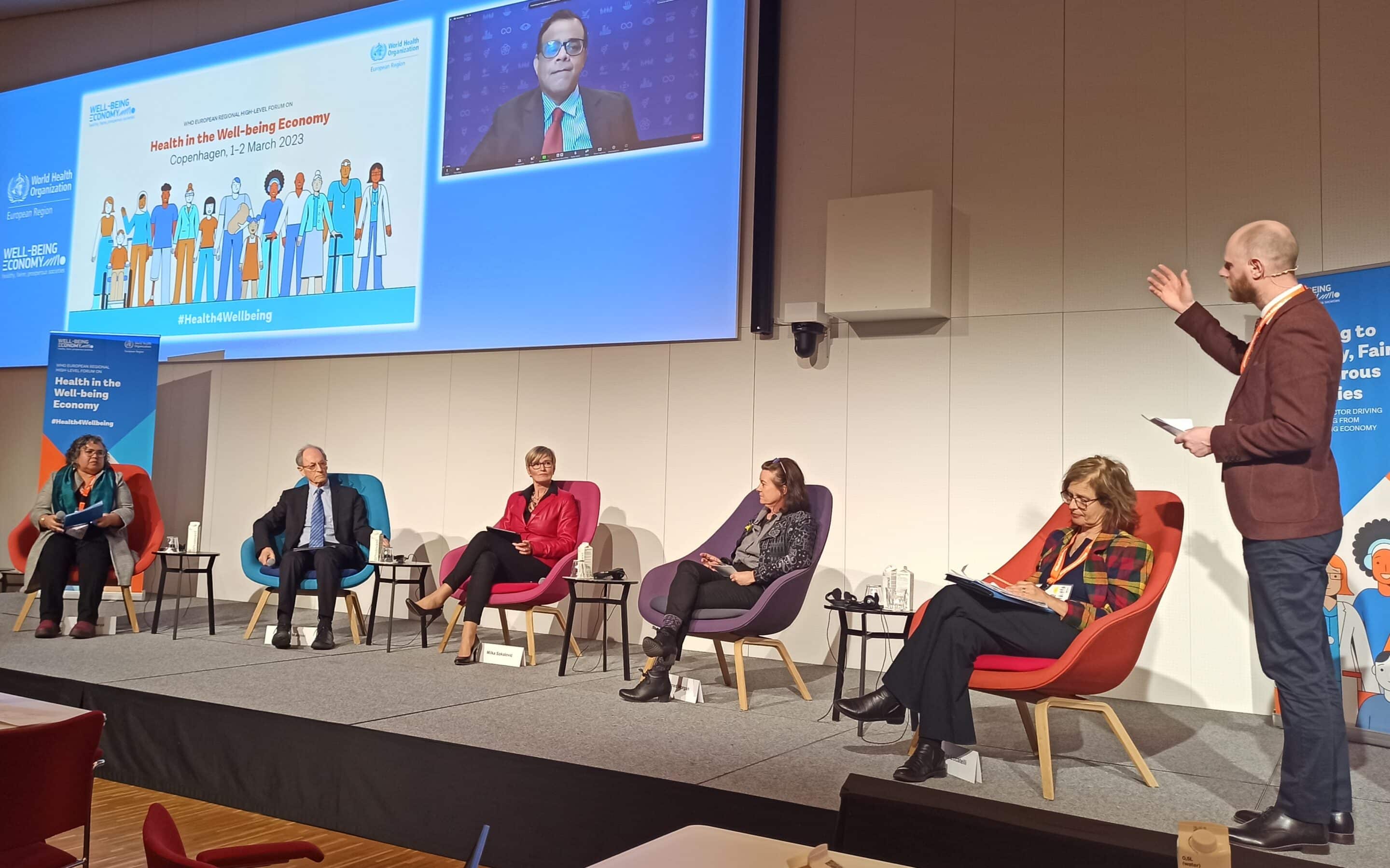Well-being economy and public health
The well-being economy provides a long-term way out of an unprecedented existential crisis, a perfect storm of climate and ecological breakdowns, pandemic and wars, the majority of which are direct products of our current economic and political systems. The well-being economy approach goes beyond the narrow, immediate, and destructive measures of growth, such as GDP, that exclusively focus on profit. Instead, it promotes investments and practices that grow human, social, economic and planetary capital by enhancing their overall well-being in a fair, inclusive and equitable way. It recognises that investing in well-being delivers co-benefits across sectors, and measures the progress and prosperity of a society, by measuring the well-being indicators of its four capitals.
The concept of a well-being economy recognises health as more than a mere absence of disease. It acknowledges economic, environmental, cultural, social dimensions of our health and well-being, and blends them with equity and planetary sustainability. It considers how happy people feel, whether they are healthy, educated, or have a home and health-conducive environment to live in. While no equation mark can be put between the approaches of well-being economy and public health, the former tightly reflects the essence of the latter, and can help improve public health and heal the social fractures and divisions that have become increasingly salient between groups in our societies.
It is important to acknowledge the failures that lay behind almost all of the social fractures that we identify today. The failures to secure health for all, equal distribution of goods, and sustainable use of resources make our current economic and political systems the actual culprit. In the times when the future of people’s and planetary health so clearly and directly depends on the decisions and actions taken today, accepting to keep repeating the same mistakes is not an option. There is no alternative to radical change.
Redesigning economic and social policies to put our societies on a pathway towards well-being for all within planetary boundaries is feasible. It can be achieved by eliminating poverty, reducing inequality, empowering women, transforming food systems, and turning around our energy use. In doing so, it is important to reinforce the positive interdependencies (e.g. between health and economy, recognising health is a key economic sector, but also critical to the resilience and stability of economies worldwide), and to take the edge off the negative feedback loops (e.g. between growth economy and people’s and planetary health.)
A societal mind shift towards growth that is based on healthy communities within the planetary boundaries is a necessity strongly underpinned by evidence from climate, environmental, biomedical and biosocial sciences. Encouragingly, this societal mind shift is on the way to becoming a reality. We see that as we are moving to a societal tipping point on environmental and climate issues. It is a matter of time before the tipping points are also reached on social justice, fairness, equity, and human rights.
Bottom-up motivated, top-down supported
The well-being economy approach can heal social fractures only if it is co-created by and for the communities it is meant to serve. For that, bottom-up, collaborative, and inclusive approaches are key. They provide the necessary demand for change, as well as the ownership and agency that will make the change sustainable.
The good news is that, without waiting for governments to act, the local community trains have already left the stations. “Community-led initiatives are flourishing, from Birmingham to Rio de Janeiro. They aim to design economies that are regenerative and distributive, sharing wealth better and meeting the needs of all inhabitants.” (Financial Times, February 2023)
These communities need support, from financial to motivational to directional, and it is great to see that some have already started receiving it from their governments. Inspirational examples include those from Iceland, Finland, and Norway, where national strategies based on well-being indicators are already in place, underpinned by legal agreements, and well-being accountability and monitoring tools. In the UK, Wales is already future-proofing its new investments by applying to them both social and economic values, while Scotland is already implementing a well-being economy framework and monitoring its impact. Other examples internationally include the practical well-being economy tool kit developed for the state of Victoria in Australia.
The techniques and technologies that governments can use for the co-creation of well-being approaches at different levels and in different communities are many, including community forums, citizens’ assemblies, inter-governmental policy forums, deliberative policy development, public policy conferences, and research on international best practices. But it is critical that governments make special efforts to empower those who have been historically marginalised, to co-create initiatives in policy areas directly relevant to them. The ‘lower’ levels must be engaged into high-level discussions – to co-create policies, not just to comment in closing plenaries of high-level meetings. This means including homeless when developing housing policy, and prisoners in prison reforms.
To achieve this, engaged, empowered, and mobilised civil society is essential – from the umbrella organisations that can help coordinate, exchange knowledge, build capacity, over the smallest of grass roots, all the way to individuals passionate about the well-being and future of their communities.
The way ahead
Clearly, securing a whole-of-society approach and empowering all stakeholders is vital, and a shift towards a well-being economy will only happen when governments, businesses, financial institutions, civil society, and communities start forging new strategic partnerships across sectors, issues, generations, and geographies. For this, two aspects may prove critical for success. One is to actively confront vested interests. Public-private-common partnerships should be advanced instead, with the business community motivated to co-create solutions to challenges to the well-being of the four capitals that we face nowadays. But above all, peace must be secured as the ultimate condition for health.
Clear, well-motivated, simple communication is instrumental for achieving the whole-of-society approach. The well-being economy is a complex concept, as for instance are the concepts of One Health, or climate change. Complex concepts need simple language, but if well communicated, in simple aligned messages, a strong buy-in can be achieved at all levels. People, regardless of their level of education, may struggle to grasp the differences between the indicators used in the Scottish monitoring tool vs. the OECD’s Better Life Indicators (which include health, education, work, social relationships, built and natural environments, security, civic engagement and governance, housing and work-life balance). But everyone is able to grasp the concept of a just, equal, future-proof society. We have seen not so long ago, that, if offered hope and purpose, people are ready to buy pretty much any concept, including populist ones like Brexit. A concept that is based on social justice, equity and a safe future for the next generations is way less of a communication challenge.
Finally, given the size of the challenge, strong leadership, ambitious advocacy, and determined action are required from all levels and at all levels. Only if we approach it courageously, inclusively, out of our own silos and echo chambers, shall we manage to instil trust, hope and agency that can secure a buy-in, ownership, and sustainability of change. In doing so, we must be radical and transformative. The time for compliance is long behind us.

